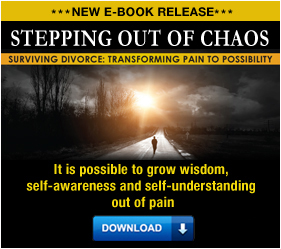By Lisa Brick
A Way Out of the Emotional and Fact Filled Forest of Divorce
There are times in life, and divorce is one of them, when situations develop or unfold so rapidly that your ability to process the information coming in is short-circuited. This is compounded when the situation unfolding is eliciting a strong emotional response. Rather than pushing through or chastising yourself for experiencing confusion and an inability to act, you can break out and use the Clarity Tool…
 The Clarity Tool provides space to STOP, INQUIRE, and CLARIFY the direction in which you want to move. The tool slows your mind down by asking you the following four questions: what?, what?, who? and how? The answers to these questions will support you in organizing your mind and choosing your next steps consciously, intentionally, and strategically.
The Clarity Tool provides space to STOP, INQUIRE, and CLARIFY the direction in which you want to move. The tool slows your mind down by asking you the following four questions: what?, what?, who? and how? The answers to these questions will support you in organizing your mind and choosing your next steps consciously, intentionally, and strategically.
Here are the questions expanded:
- What is the most pressing issue for me in this situation?
- What ultimate outcome do I desire around this issue?
- Who else is involved if I am to achieve the ultimate outcome I desire?
- How can I present the situation to those involved in such a way that will enroll them in achieving the outcome I desire?
Example: Sal and Jenny are divorced and have shared custody of their children. The principal at their nine year old son’s school calls to request a meeting, sharing that there is concern about behavioral issues their son is exhibiting at school. Both Sal and Jenny attend the meeting along with the principal, the school counselor, and their child’s lead teacher. They are informed that their son has become unusually withdrawn in the classroom, is struggling with completing work during the school day, and has gotten into a few recess arguments lately. The counselor shares that their child has expressed difficulty going between their two homes and feels torn in his loyalty. The team presents an assessment of the situation and recommendations for the two parents to consider.
Sal is grateful to the team for sharing this information. Jenny avoids eye contact and is silent. As they leave the room Jenny walks away quickly. Sal catches up and asks “when can we talk about this together?” Jenny responds “I’m busy now. After I get back from vacation.” She gets in her car and takes off.
Sal’s anger and frustration overtakes his mind. In his mind Jenny was uncooperative and irrational during the divorce and “she’s doing it again”. On top of this, Sal is reeling from the news that his son, whom he thought was doing well, is showing signs of distress affecting his ability to learn and his social interactions. He feels a rush guilt and shame on top of the anger and frustration. He gets into his car, puts his head in his hands, and sits there with a million thoughts filling his brain…how much he has to do, how futile it all feels, how incompetent he feels as a parent, how challenging it is to do it all alone, how stressed he feels financially, how sad he is that his son is suffering…
He remembers the Clarity Tool. He says to his mind STOP and begins to inquire:
- Question: What is the most pressing issue for me in this situation?
Answer: That changes are made that will support my son to be comfortable in his skin again.
- Question: What is the ultimate outcome I desire?
Answer: My son comes out of this period healthy.
- Question: Who else is involved if I am to achieve the ultimate outcome I desires?
Answer:
- Jenny
- the team at the school
- possibly the divorce attorney and the courts
- possibly a private or family counselor
- my son
- oh, and me
- Question: How can I present the situation to these individuals in such a way that will enroll
them in achieving the outcome I desire?
Answer:
- Jenny – present her with the school’s analysis and recommendations in writing to review together so we are both looking at the same information
- Team – request the school officials create and send out the above document so Jenny and I can minimize conflicting accounts of what we heard when we get together to brainstorm how best to support our son
- Attorney – keep copies of all communications in case Jenny is uncooperative and l need to resort to the courts to force the changes necessary for my child’s well-being
- Counselors – get a few recommendations for counselors, call to interview themand find out what their fees are so I am prepared if I find additional help is warranted for me or my son
- My Son – listen to him, observe him more closely, be more sensitive to him overall
- Me – be aware of the messages I am giving my son and look at what changes I can make on my own out of what I now know so my kids and I emerge from this period of our lives healthy.
 The Clarity Tool provides a path through the wilderness of facts and feelings, allows you to prioritize looking at the big picture, and choose action steps that are aligned with the ultimate outcome you desire. It makes the difference between making near-sighted actions that forfeit long term gains or taking near and far-sighted actions that maximize long term gains. Slowing down and using the Clarity Tool lets you live smarter, not harder. It reduces pain.
The Clarity Tool provides a path through the wilderness of facts and feelings, allows you to prioritize looking at the big picture, and choose action steps that are aligned with the ultimate outcome you desire. It makes the difference between making near-sighted actions that forfeit long term gains or taking near and far-sighted actions that maximize long term gains. Slowing down and using the Clarity Tool lets you live smarter, not harder. It reduces pain.




